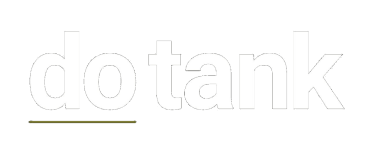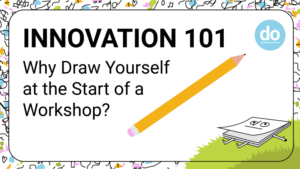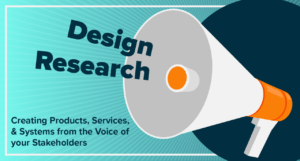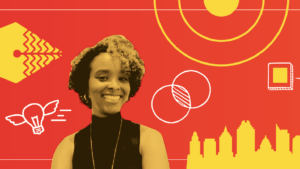Meet Bruno Suarez Bango, artist and lead Visual Designer at Do Tank. “Artist and visual designer?” you say, “that’s the same thing!” Well—sort of.
Art is about expression and viewing the world subjectively. Visual designers are flexible, skilled, and always aware of their target audience—in their world, it’s all about problem-solving and visual communication.
Every creative professional comes with a rolodex of influences that blend into their current work, and Bruno is no exception. We chatted with him about design philosophy, visual inspirations, and the art behind human-centered business design. Here is a summary of our conversation.
How does visual design relate to business design?
Visual information is in every step of the business design process, from beginning to end. If you are working with a new business, you need to get into their customers’ shoes (and, more importantly, their brains). Every single entity in the world is competing for eyeballs. You’re just tuning your brand to the right audience.
“Every single entity in the world is competing for eyeballs. You’re just tuning your brand to the right audience.”
It’s more complex when you’re working with an established organization. You need to stay loyal to what the customer expects (to avoid alienating your audience) but subvert expectations just enough to keep things interesting. Everything deserves the same attention to detail, whether it’s internal presentations or public-facing materials. Do Tank takes all of it seriously, and people see the difference.
Got any examples?
How about a metaphor? We worked with a designer who described the work we do as “therapy for businesses.” I like that! Sometimes we help new companies establish their brand, other times we help big companies break down silos and get scrappy.
There’s not a single step in this therapy process that doesn’t use visual design. Visual design is obviously about the eyes, you need things to feel good, look good, and capture attention. On the other hand, business design questions our assumptions.
“Business design questions our assumptions.”
Is there a communication flow between separate departments? Is this material biodegradable, or just recyclable? Will this product function in a tropical weather climate?
These are some of the questions that our clients think about every day. And to answer these questions, we use visual thinking and creative problem-solving.
Describe your role in two words.
“Adult play.” This is a phrase I learned from a former graphic design teacher named Don Pollack. I loved his class because we focused on collaging and analog processes and weren’t beholden to the computer. In design, if you don’t enjoy the process, it shows in the work. My day consists of deciding between colors and fonts, not deciding which wires need to be cut to diffuse a bomb.
“My day consists of deciding between colors and fonts, not deciding which wires need to be cut to diffuse a bomb.”
Human-centered design is about empathizing with your audience. How does your role as a visual designer change the way you see, categorize, and interact with people?
It’s cliché, but you can’t judge a book by its cover; there’s always a huge gap between a person and the mental image you have of them.
I love when people insert their personalities into work and show pieces of themselves, like using Zoom backgrounds. Online meetings can get very stale and boring, and the devil’s in the details. We helped one client change their strategy, increase interdepartmental communication, and redesign their Zoom backgrounds— this really stuck with me. It sounds trivial, but it’s funny how simple things can fundamentally change the way people see each other.
People often see visual design as creating static graphics. What else do you do?
Working in photoshop is a big part of my day, but it ain’t the whole thing.
Visual Designers at Do Tank start by talking with clients, fleshing out concepts, and pitching materials. People know what they want, they just need a little bit of guidance to know what’s possible. Not everyone’s an artist, but everyone’s an art director.
I love when we go to in-person events and see our visuals come to life in print. There’s also the hands-on filming, interviewing, and setting up booths—that’s always a treat after weeks behind a screen.
Artists are defined by their unique style, but visual designers are more nimble; creating unique pieces within tight guidelines. Can you explore this more?
It’s true. You have to both improvise and amaze while staying in your lane and not attracting the wrong attention. Good design is invisible; great design sticks with you after you look away.
Many designers view the “brand guideline” as a limitation, but I believe great design comes from innovation. Our designer Cat Mcyver-White is a really good example. She’s amazing at bending the rules of a brand guideline, especially in the UX space. She can use the same colors and fonts a brand has seen for years and make something different.
You have to be able to read the sheet music and write your own song. Brand guidelines can be seen as visual limitations, but when approached with creativity, these limitations can inspire revolutionary ideas.

I’m living in Santiago, Chile right now. Art from the military coup period had tongue-in-cheek, hidden meanings all over the place. Why? Because you couldn’t be obvious about your ideas, or the military would stomp them down, throw you in jail, or worse. With business-to-business work or internal work, you’re allowed to embrace a similar kind of subtlety. People are already used to the brand. So, they notice the little things.
What’s the most satisfying impact you’ve fostered this month?
Now that I’m the Design team supervisor, I am even more invested in the impact of our work. The visual design work that we do fosters tangible change for our clients in their businesses and their modes of thinking and creative problem-solving.
One of our designers, Lauren Cox, is working on a massive event for one of our clients, and I’m supervising her storyboards and animations. Creating custom visuals, portraits, and canvases for big organizations’ events is tough, detailed work, but it’s exciting to see her designs come to life and inspire so many people.
“Good design is invisible; great design sticks with you after you look away.”
Our weekly design meetings are great, too. We share assets, laughs, and constructive criticism within our visual team. It matters to me that our designers feel supported, and I think that kind of dynamic is pretty rare in the corporate world.
Visual design isn’t tied to a specific country, nation, or border. As a bilingual person, what’s your take on art’s ability to transcend boundaries? Why is this important?
Let’s look at two different examples. First, “The Kid” by Charlie Chaplin. It’s a silent movie that you can put up anywhere, any time, at any moment, and people are going to feel it. People will understand and react to the emotional turmoil each character goes through. Sure, there’s a bit of text that goes up during dialogue, but it’ll take you 10 minutes to translate the whole thing. So, you don’t really need the text.

Another example, another comedy: The Simpsons. Created 100 years later, The Simpsons is a critique of sitcom perfection in the eighties and the seventies. The Simpsons point towards the ugly parts of the United States and make fun of it. I think it’s the greatest comedy ever made because of that.
But how can you possibly translate that to another culture? Imagine 30 producers in a room going “Oh my God, how the hell are we going to market this for the world?” Simple, you trust another set of artists.
As an English and Spanish speaker, I think the Spanish version of The Simpsons is superior to the original in many ways. The voices are incredible because they had to re-conceptualize a bunch of political, Americanized jokes and change them in ways that make sense to a Spanish-speaking audience.
So, there are two different approaches to art. You either create something universal that everyone can understand, or you create something culturally specific enough to get lost in translation.
How does this apply to the business world?
In all fields of design, it’s important to think about other markets. An obvious example is the Chevy Nova.
The Chevy Nova is a muscle car from the 60s that didn’t have the right market research. “No va” means “doesn’t go” in Spanish, which is the last connotation you’d want for a sports car. Chevy failed hard in Spanish-speaking countries because no one took it seriously. For a successful business launch, you need good cultural and visual research to cover your back.
One of our designers Jade Goodwin-Carter talks more about the research behind project launches in this interview.
What outside-of-the-box inspiration is your go-to?
Understanding comics, by Scott McCloud, has had a huge impact on my professional life. I even created a flip book series based on his work. When I eventually met Scott, I gave him the first edition of the series. Comics can teach you a lot about visual storytelling and are a beautiful medium all on their own.

The most visually stunning city you’ve visited?
In the United States, nothing beats NOLA. Everything oozes style, and the food is the best. As an Ecuadorian, NOLA reminds me of Latin America in all its craziness
Abroad, I would say La Paz, Bolivia. Maybe it’s recency bias, but no matter where you are in the city the views are unbelievable. They use gondola lifts as public transportation and there are mountains in every shape and size surrounding the city. Truly underrated.
Ready to work with Bruno on your next project? Reach out at dotankdo.com or on Linkedin!









